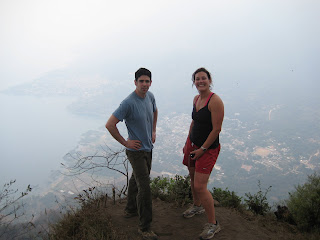

I love the kids here. What keeps happening is, I'm talking to someone and there's a little kid behind them looking at me. I smile and the kid and he or she erupts in a huge smile. Or I'm walking down the street and there's a young person passing the other way. We make eye contact and the same thing happens -- explosive smiling.

Monday the 13th I went with some Canadians to a town called Chacayá. It's at the southern tip of the lake, far from the tourist path. The Canadians come down for a few months each year to work on various projects. Improving the schools, installing better woodstoves, introducing new crops, among other things. We went to three schools where we met with the directors. At the first, a primary school, the director Diego showed us a computer class. They were using a type of Compaq that I was throwing away in 2001. They have 4, but only 2 work, so I told them I'd be happy to see if I could make one out of the two dysfunctional ones. He's going to drop them off Friday.

Chacayá is extremely steep. There's no running water now -- the motor died apparently. Girls walk 1-2 km to the lake with traditional-looking plastic jugs several times daily. Diego showed us the UV filter that has been installed for water when it flows again. It's nice and modern just a few feet from toilets that haven't flushed in over a year, yet still get used. Yes, they smell.

The girls basketball team won a game in the recent olympics at Santiago. They were pretty happy! Next to the court is a drop-off into the cornfields where the ball goes often. It's a real chore to retrieve it. One of the projects the Canadians are doing is building a wall around the court so the ball won't go downhill as often.
At the school farther downhill we spoke with director Pascual. This school was in a different spot last year. The "building" was a dirt floor with cornstalk walls and plastic sheets separating the "rooms". Over 100 kids in about 1000 sq. ft. The noise was awful, I'm told. Now the building is new and pretty nice. The school is in the process of becoming official -- it was more of a private school last year (I forget the phrase...). Pascual is traveling to Sololá today to file some paperwork -- there are thousnds of steps involved in making the school official. Most of the teachers will get paid pretty soon, and have contracts!

Later in the afternoon we went back to the first school and met with the director of the middle school. Chacayá just opened it last year, and next year will be adding ninth grade. These teachers haven't been paid at all. The director, Rosa Viviana, lives in Santiago and spends 7Q daily traveling back and forth. She's probably about 21 years old, and is not shy about asking for things she needs for the school, such as books, musical instruments and cement to finish off an office. Greg (one of the Canadians) and I are meeting her again Wednesday. She's interested in exploiting my technical and educational experience, and I'm looking forward to helping out, but it's going to be hard. In Santiago the schools have computer labs, but they won't share with the hicks from Chacayá. They do let them use typewriters, however.
Here's another family we met on the way back -- Elisa, little kid(?), Rebeca, María, boy(?), David.































